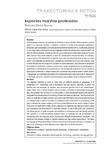Mostrar o rexistro simple do ítem
Especies mariñas protexidas
| dc.contributor.author | López Fernández, Alfredo | |
| dc.date.accessioned | 2009-11-10T11:51:31Z | |
| dc.date.available | 2009-11-10T11:51:31Z | |
| dc.date.issued | 2007 | |
| dc.identifier.citation | Ambientalmente sustentable 2007, 4: 51-59 ISSN: 1887-2417 | es_ES |
| dc.identifier.issn | 1887-2417 | |
| dc.identifier.uri | http://hdl.handle.net/2183/5047 | |
| dc.description.abstract | [Resumo] A costa galega conta con 20 especies de cetáceos, 6 de pinnípedes, 6 de quelonios, unha de selacio e un carnívoro acuático, e destacan o arroaz e a toniña como especies residentes e protexidas, pero ameazadas. Dunha situación social de descoñecemento, hai décadas, pasouse a unha fase onde a participación social intégrase na rede de varamentos e monitorización. Os máis de 200 exemplares varados ao ano fan que a información sobre estas especies flúa dun xeito habitual. Para poder abordar un labor de conservación cómpre identificar as ameazas, o cal no mar é unha tarefa difícil, e deseñar unha serie de actuacións entre as que se poden contar: unha rede de varamentos para a asistencia e rehabilitación dos animais varados; unha unidade de estudios de campo con contacto co sector pesqueiro, para abordar os problemas da interacción pesqueira; a posta en marcha dun equipo multidisciplinar de investigación; o incremento e consolidación da monitorización coa conseguinte implicación social a través do voluntariado ambiental; o cambio estrutural e transversal das políticas sobre o medio mariño; a necesidade de elaboración de planos de conservación para a pervivencia de P. phocoena e T. truncatus, así como a revisión doutras especies que puidesen estar na mesma situación. | es_ES |
| dc.description.abstract | [Abstract] The Galician coastline is home to more than 20 different species of cetaceans, 6 of pinnipides, 6 of chelonians, one of selachians and one aquatic carnivore, of which the dolphin and the porpoise as resident and protected species which are, nevertheless, under threat. From a social situation which revealed a total lack of knowledge some years ago, the situation has moved on to a new phase in which social participation has become integrated into the network of monitoring animals that have run aground. The more than 200 cases of creatures run aground each year mean that information about these species flows in a habitual way. In order to be able to undertake a task of protection it is necessary to be able to identify the threats, a labour which is of great difficulty at sea, and to design a series of actions amongst which there can be a Network of Creatures Run Aground which would give assistance and rehabilitation to beached animals. A unit of field work with contacts in the fishing sector, in order to tackle the problems of interaction with the fishing industry. The creation of a multi-disciplinary research team. An increase and the consolidation of monitoring with the resulting social involvement through environmental volunteers. The structural and oblique change in policies dealing with the marine environment. The need for drawing up Protection Plans for the survival of the P. phocoena and the T. truncatus, as well as the checking of other species which might be in a similar situation. | es_ES |
| dc.language.iso | glg | es_ES |
| dc.publisher | Universidade da Coruña | es_ES |
| dc.subject | Conservación | es_ES |
| dc.subject | Ameazas | es_ES |
| dc.subject | Especies mariñas protexidas | es_ES |
| dc.subject | Monitorización | es_ES |
| dc.subject | Varamentos | es_ES |
| dc.subject | Protection | es_ES |
| dc.subject | Threats | es_ES |
| dc.subject | Protected marine species | es_ES |
| dc.subject | Monitoring | es_ES |
| dc.subject | Creatures coming aground | es_ES |
| dc.title | Especies mariñas protexidas | es_ES |
| dc.title.alternative | Protected Marine Species | es_ES |
| dc.type | info:eu-repo/semantics/article | es_ES |
| dc.rights.access | info:eu-repo/semantics/openAccess |






